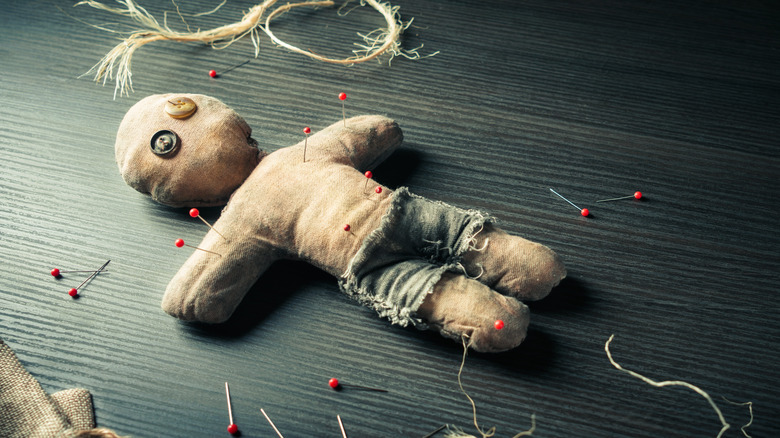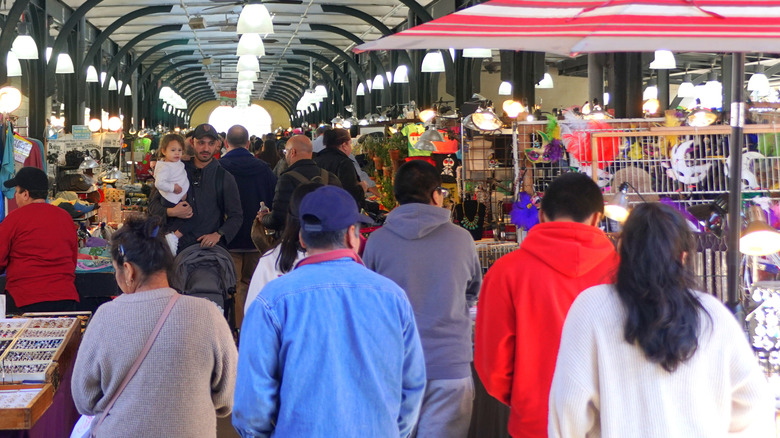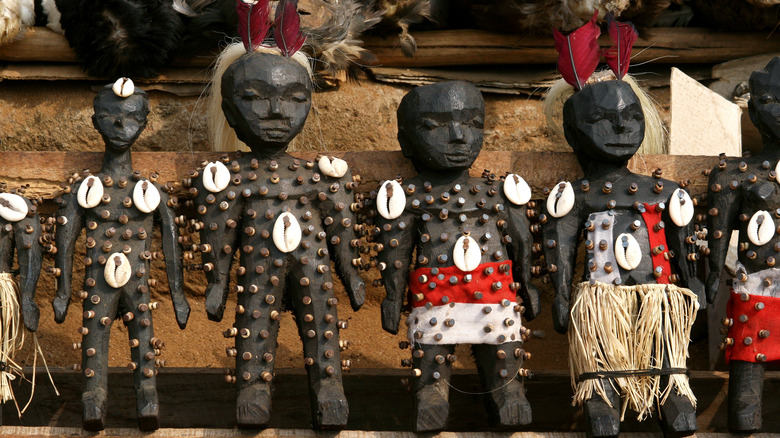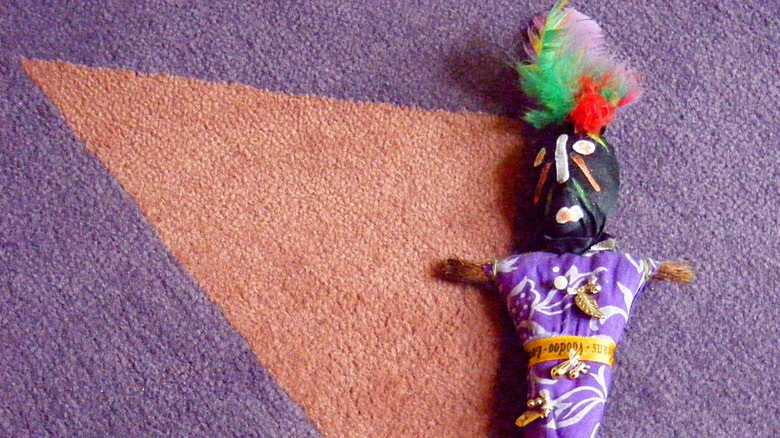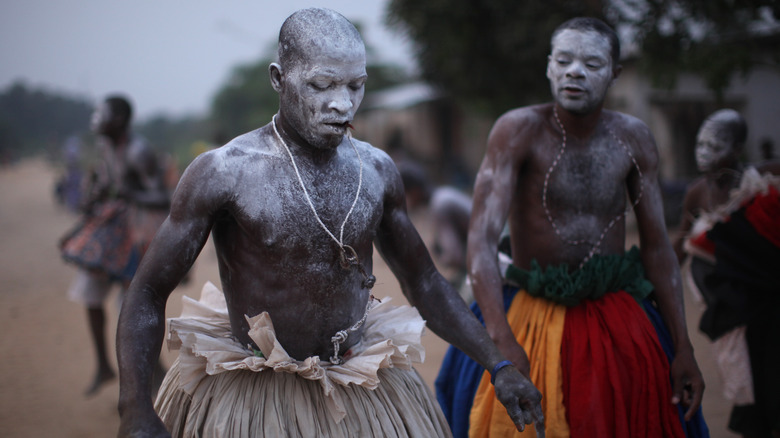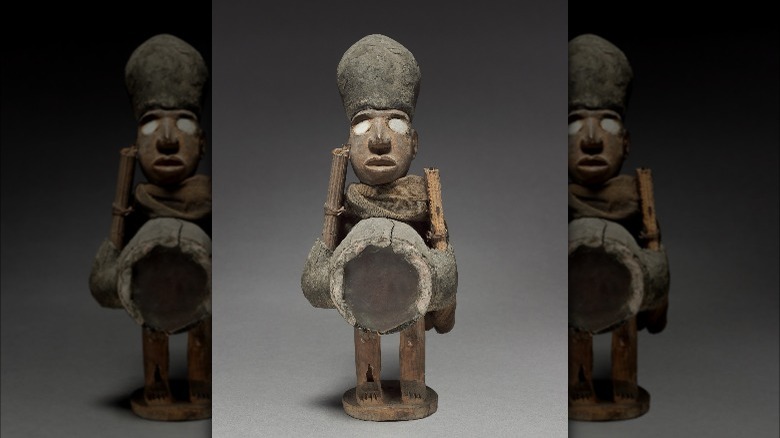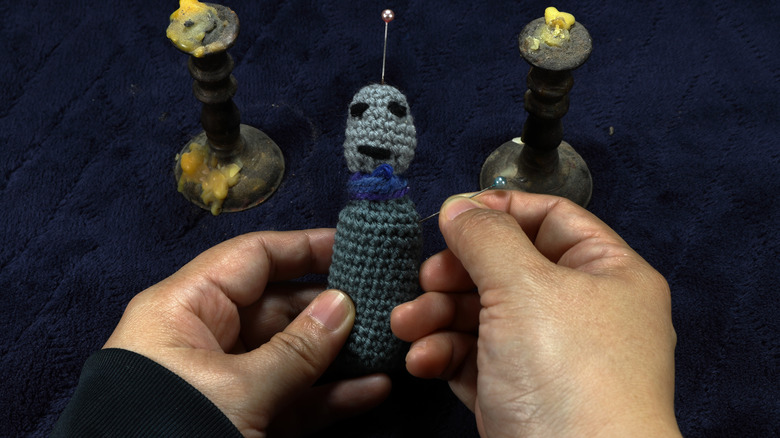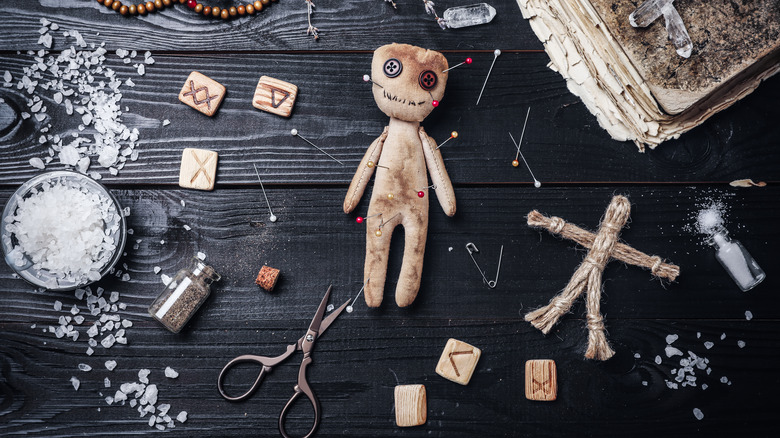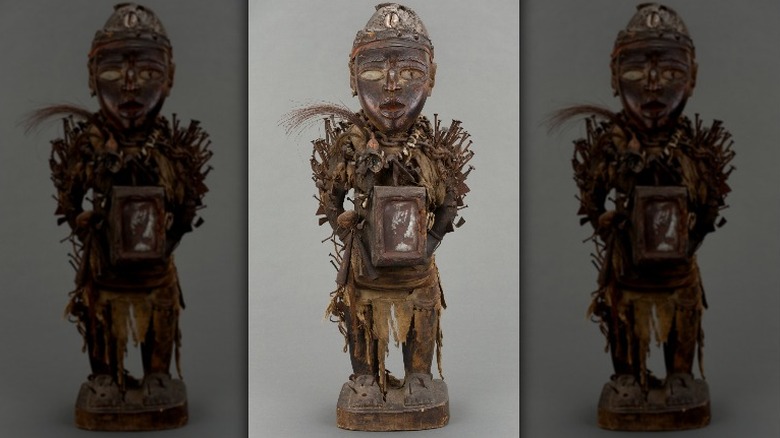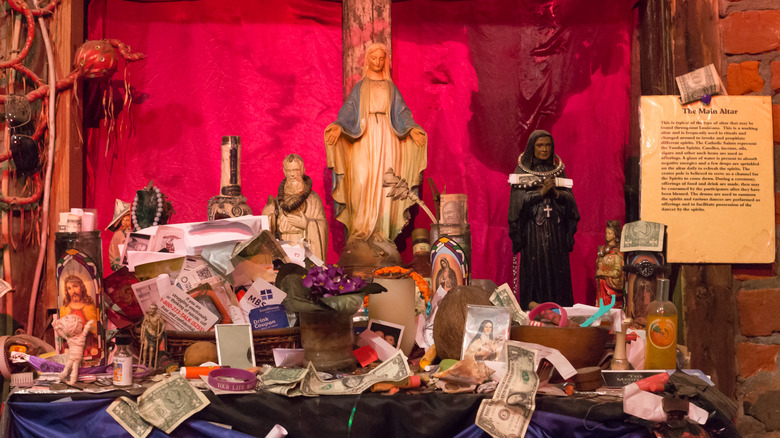The Untold Truth Of Voodoo Dolls
Voodoo dolls can be found in virtually every open market and tourist shop across New Orleans and beyond. Their appeal as decorations is even more widespread — they dangle off zippers on backpacks, they sit on shelves, they imbue any given room with an aura of darkness and power.
The voodoo doll has a pretty well-established image in popular culture. It's a small figure that very loosely resembles the intended target — the person the voodoo doll is meant to curse. The bearer of the doll inflicts all sorts of tortures on the little figure, and those tortures are enacted on the target as an act of revenge, or just general cruelty. Pushing pins through the doll is most common, but you could also set it on fire, rip it apart, or damage it in any number of other creative ways.
All of that is dead wrong. Hypothetically, if you want to use them that way, you could give it a shot (though you should probably try counseling too). But that's not what voodoo dolls are intended for at all. According to Live Science, it's just one of the many misunderstood parts of the voodoo faith, alongside animal sacrifice and zombies — one of many misconceptions that have stolen the spotlight from what the followers of voodoo actually believe and practice.
What Hollywood has made of voodoo dolls has little in common with their actual history and use. Let's dig into the untold truth of what voodoo dolls really are.
They're a tourist trap
There is one central location that most people probably think of when they think about voodoo dolls and where they can get an "authentic" one, and that place is New Orleans (though Haiti certainly has its share of choices as well). Every gift shop you go to in New Orleans has some form of voodoo doll you can purchase, even if it's just a keychain or a pin. There are bound to be some authentic ones sprinkled in there, but the gross majority are misrepresentations meant as souvenirs and not actually used by voodoo practitioners, according to Learn Religions.
The site goes on to explain what these touristy dolls look like, and how they are all essentially the same: two sticks woven together to form the shape of a person, some sort of cloth covering, black sewn eyes, and decorated with various pins or feathers to give it a little personality — none of which matters in the least aside from making your doll look better than the next tourist's effigy.
Take a look at the actual voodoo dolls on display at the practitioner-owned Voodoo Authentica, and you'll see the difference between what any given gimmick shop is selling, and what an authentic voodoo doll looks like and is intended for.
They are incorrectly linked to cashew dolls
There are many, many examples throughout history of human effigies being used for various purposes, and yes, sometimes those purposes were a bit nefarious. But the modern idea of the voodoo doll may come from a much younger source: cashew dolls imported from Haiti in the 1950s.
These cashew dolls were meant to quench Americans' growing desire for something exotic in the 1950s, according to "The Faces of LaFwa: Vodou & Ancient Figurines Defy Human Destiny," by Sara Rich. Unfortunately for the children who might have received them, these dolls could have been lethal. The eyes were made of jequirity beans, which contain a toxin similar to poison ivy that could be fatal to infants if swallowed. In 1959, the U.S. Public Health Service issued a warning about the lethality of these dolls. That warning contributed to the negativity surrounding voodoo and voodoo dolls, even though cashew dolls were completely different entities. It became its own stereotype, with the general public lumping all similar-looking dolls into the category of voodoo dolls, when in fact there was very little relation between them.
As with most stereotypes, however, this one has proven tough to stomp out, with many people still associating all voodoo dolls with one specific, evil purpose.
They are powerful ritual objects
To understand the power of the voodoo doll, we first have to get into a bit of voodoo beliefs. There are many rituals in the voodoo faith, and any time items are used in those rituals to link to the spirit realm, those items become "pwen," according to Learn Religions. The purpose of a pwen object is to appeal to a deity of the voodoo faith, entities referred to as Iwa or Ioa. Each pwen is specially made for a particular Iwa, and would include objects that spirit is drawn to. The end goal was to recruit the support of that particular deity in whatever the ritual is meant to achieve — perhaps safe travel, good weather, or better focus.
Not every pwen is a doll, but dolls are one type of pwen, and one of the more common ones. Not all pwen are even physical objects. They can be practically anything. For the doll versions, however, Learn Religions points out that the doll can be anything from an elaborate effigy to the simplest of representations. But their purpose is the same: to heal, to protect, and to guide.
Once the object has served its purpose, the object loses its pwen, and the spirit returns to wherever it came from, leaving the effigy as little more than a statue.
They originated in West Africa
In order to properly understand voodoo dolls and their misunderstood timeline, it's also important to at least somewhat understand voodooism and its misunderstood timeline. While most associate voodooism with New Orleans and Haiti, where it's centered today, the people of Haiti brought it over from their own starting point in West Africa. When they were enslaved and brought to the Americas and the Caribbean, they brought their faith with them, and that includes the rituals associated with effigies and dolls, according to Learn Religions.
That said, they aren't the only people to use dolls in religious rituals. Some Native American tribes use kachina dolls to represent the spirits they revere. The ritual use of dolls has also been documented in history across the Middle East and into Europe, but with the growth of religions such as Christianity and Islam — neither of which takes a sympathetic stance toward effigies — the ritual use of dolls has declined.
They are used for positive purposes
Not only are voodoo dolls not meant to be used for evil purposes, they are in fact intended for the complete opposite. They are meant to be used for someone who needs help, though the definition of that help can vary from person to person. The type of help needed will dictate which type of doll will be used. For medicinal purposes, a witch doctor or voodoo queen will create a minkisi — a wooden human effigy with a pouch to hold medicine meant to heal whoever requested the piece be made. Once they are cured, the medicine is removed and the doll essentially "dies."
There were other positive influences that dolls could be used for as well — to ensure a happy marriage, to help children pass school tests, and to provide protection on a journey, just to name a few (via Joukowsky Institute for Archaeology & the Ancient World).
According to Learn Religion, dolls could also be hung from trees near graveyards to allow the spirit realm to be reached when needed. And speaking of the spirit realm, the Brooklyn Museum tells us the type of dolls known as "nkondi" were used to employ the spirit realm in finding a wrongdoer.
All positive things — nothing having to do with revenge or torture.
They have to be made of the right stuff
When touristy shops sell "voodoo dolls" meant to decorate backpacks and knapsacks, the only thought put into those dolls is usually what will make the most profit, hence their simplicity. According to the Joukowsky Institute for Archaeology & the Ancient World, the ingredients required for such dolls include simple things like cotton, moss, and cloth — all the easier to poke needles through, and all easily attainable so as not to be too expensive or labor intensive.
On the other hand, actual dolls made in the voodoo faith, known as minkisi, had very specific material construction and a very specific creation process. But the most important part of the whole doll was the pocket, which was either worn around the neck of the doll or carved into the doll itself, perhaps in the stomach area to replicate where the healing would take place in the intended subject. It's in that pouch or pocket that the healer would place medicinal tidbits, which ran the gamut from animal parts, to healing herbs and seeds, to stones from graveyards.
Then there were the nkondi effigies, which were also wooden figurines, but these ones would have nails driven through them in an attempt to call the spirit realm for assistance in outing a wrongdoer, according to the Brooklyn Museum. These figures were similar to other minkisi in composition, but they don't include a pouch, and they are run through with multiple nails.
The creation process is very specific
It's not an easy process to make a proper voodoo doll. It happens in multiple steps, and the makers are never to be known to each other, according to Joukowsky Institute for Archaeology & the Ancient World. It starts, as Kongolese writer Nsemi Isaki once said, with the creation of the physical doll. He described the entire process (via Joukowsky Institute for Archaeology & the Ancient World): "In the past, when men carved figures they would first look closely at someone and then according to their skill cut down a tree suitable for carving. A carver would put eyes, ears, nose, mouth, neck as he had observed them. When he had prepared these features, if he had represented the person correctly, then it would look like him. For that reason they first shape the face and the whole head and neck and then finish the lower part."
That was just the first part of the process, though. It would then fall to a witch doctor or voodoo queen to bring the healing qualities to the doll, perhaps through the use of medicinal bits and pieces crammed into a small pouch, according to Joukowsky Institute for Archaeology & the Ancient World. This step could only be performed by a qualified voodoo healer, much like how Western medicine only prescribes medication through licensed doctors. Each doll pouch would hold different ingredients depending on what the patient wanted to accomplish with that particular doll.
They may get their bad attributes from distinctly non-Voodoo examples
For all the links between voodooism and Caribbean and West African peoples, there are plenty of other examples around the world and throughout history where dolls were used in an attempt to change fate. According to Sara Rich's "The Faces of LaFwa: Vodou & Ancient Figurines Defy Human Destiny," an example from ancient Egypt was found where two dolls were used to bind one lover to another. One doll was fashioned with a sword to the other's neck. The person attempting the magic was given specific instructions to pierce the head of the doll with a copper needle and say. "I am piercing your brain [insert name of victim]." They were then supposed to insert 12 more needles into the effigy's ears, eyes, mouth, midriff, hands, genitals, and feet, saying each time, "I am piercing such and such a member of her, [insert victim's name], so that she may remember no one but me, [insert name], alone."
Another instance is found in ancient Assyria, where two kings bound themselves to each other through their dolls, saying, "As this wax is consumed by fire, thus [I] shall be consumed by fire. ... As a man of wax is blinded, thus [I] shall be blinded," (via "The Faces of LaFwa: Vodou & Ancient Figurines Defy Human Destiny").
Both of these examples sound like what we think of as traditional voodoo-doll magic, but they have nothing to do with the voodoo faith.
They may also be conflated with Nkondi dolls
There is a very popular image associated with voodoo dolls: the image of nails or pins being driven into the doll. This is almost entirely done with the goal of torturing the victim the doll is meant to plague. The nails bit isn't unfounded, actually, but the torturing bit is. There is another kind of effigy used by the Kongo people, made of wood like a minkisi, and this effigy is meant to have nails driven through it. These dolls are a type of minkisi known as "nkondi."
However, like other minkisi, the purpose is not evil, but benevolent. Each time a nail is driven into the figure, help is called for from the spirit realm to hunt witches and villains, according to the Brooklyn Museum. So while the notion of pushing a nail into a wooden man may seem violent, the intent was to ask for assistance in stopping wrongdoing. When someone in the village or community then suffered headaches and pains, they were pinpointed as the culprit and punished accordingly. Then someone could inflict damage on the nkondi or remove some of its components to neutralize its power.
According to Joukowsky Institute for Archaeology & the Ancient World, these were considered the most important effigies in the African faith before missionaries stomped out the practice for fear of evil, even though they were in fact used to protect against evil.
They aren't intended to be art
Whatever your aesthetic visions, that's completely on you. If you want a living room with voodoo dolls swinging from a ceiling fan, by all means, swing away. And given the sheer diversity of voodoo dolls available, it's easy to find the right one for your purposes, whether you want it clipped to your purse or sitting over the mantle. However, in the voodoo faith, these objects were never meant to be artistic. According to Joukowsky Institute for Archaeology & the Ancient World, once the doll accomplishes its task, it is considered dead and has no further purpose.
Even if the dolls aren't intended as art objects, there will always be exceptions. Renee Stout, an artist who makes minkisi, compared an effigy in a museum to a church without a congregation (via Joukowsky Institute for Archaeology & the Ancient World). There is still something there to look at, but any and all spiritual power is essentially gone.
That said, it's not like they strictly can't be used for art. There are plenty of them displayed in various museums around the world. They just have to have served their purpose first, and then they become a regular statue, devoid of any of the purpose they once had.
